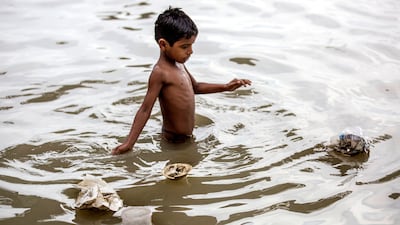It is both India's mightiest river and a national eyesore. But India is determined to clean up the polluted Ganges river in every sense.
The country’s top environmental tribunal has issued new, strict regulations aimed at cleaning up the dirty waterway and reviving a project that prime minister Narendra Modi made a plank of his election campaign but which has lapsed into inactivity in the three years since.
On Thursday, the National Green Tribunal ruled that no waste can be dumped within half a kilometre of the river’s edge, and that any littering of any sort will invoke an instant fine of 50,000 rupees (Dh2,850).
There will be no construction allowed within 100 metres of the river. The state of Uttar Pradesh, through which the Ganges flows, is under orders to move 456 tannery units, which release effluent into the water, away from the river within the next six weeks. If they are not relocated, they will be closed down.
The new orders were issued by a six-member bench of the tribunal, headed by a former Supreme Court justice, in a 543-page judgment.
The tribunal noted that despite successive governments spending US$1.13 billion (Dh4.15bn) over the years on combating pollution in the river, there has been no improvement. “On the contrary, there has been tremendous increase in the pollution levels, adversely affecting the water quality of the river Ganga and its tributaries,” the tribunal concluded.
The Ganges, also known as the Ganga, flows across the plains of north India and is considered the most sacred river in Hinduism. Pilgrims immerse themselves in its waters to wash away their sins, and the ashes of the dead are consigned to its depths.
The Ganges is also the primary source of water for nearly 400 million people, who rely upon it for domestic and industrial use.
But the river has also become deeply polluted by industrial waste and untreated sewage being released into the water over its 2,500-kilometre length. Nearly 120 cities and towns on the river's banks dump roughly 4.8 billion litres of sewage into the river every day, three-quarters of it untreated. An additional 500 million litres or so of industrial effluent gush into the Ganges daily from 760 industrial units.
State indifference to this pollution has turned the river a sickly grey — and even red, in some stretches. Scientific studies have recorded sharp increases in skin diseases among people living along the river, as a result of the pollution.
During his 2014 campaign, Mr Modi promised to revive the river, and after winning office, he instituted the National Mission for Clean Ganga, a body to supervise nearly $3 billion in funding during the 2015-2020 period. In February, however, the tribunal found that only $205 million of this money had been spent, and “not a single drop of the Ganga has been cleaned so far.”
The river’s decline has also affected how people regard its sacred purity.
In Varanasi, Hinduism’s holiest city, a priest named V Krishnamurti helps pilgrims conduct rituals. He is a fifth-generation priest, and his profession depends, in a sense, on the sanctity of the Ganga’s water.
But his clients have increasingly begun to look askance at the river, in a way they never did two or three decades ago, he said. And they ask him if there is a cleaner spot further upstream for them to perform their ritual immersions.
“Even a few years ago, I noticed that Varanasi’s families no longer use the water to clean or to cook, let alone to drink,” he said. “It’s so sad, because the Ganga’s water is supposed to cleanse us, and instead, we’re uncertain of its own cleanliness.”
However, the tribunal’s ruling is only the latest in a long line of judicial decrees that have gone unheeded or unimplemented, said Rakesh Jaiswal, a seasoned clean-up campaigner and the founder of EcoFriends, a Kanpur-based environmental non-profit organisation.
Earlier, the Allahabad High Court declared the area 200 metres from the river's edge would be a no-development zone. "But it was never complied with. Not a single person has been penalised for polluting the river despite court orders, " Mr Jaiswal told The National.
Some of the tribunal’s directives are difficult to carry out in the time frame specified, he added. “Shifting of these tanneries within six weeks seems impractical.”
He attributes the river’s decline to apathy and bureaucratic corruption, which render even well-intentioned regulations toothless.
“There is a lack of dedication and honesty at every level,” Mr Jaiswal said. “Let the tribunal’s orders be implemented. There is very little hope.”

